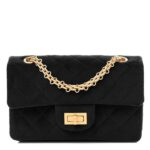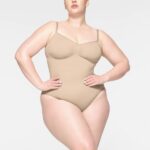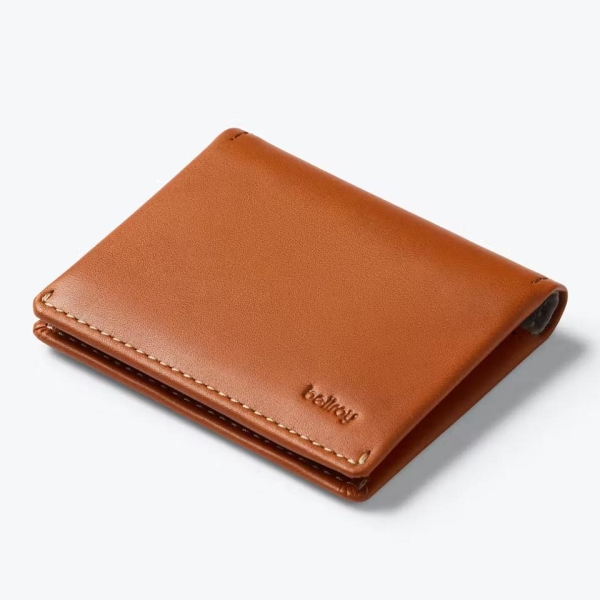
Bellroy Slim Sleeve
Type: Slim wallet | Material: Leather | Holds: 11 cards (though I suggest 4 max) | Dimensions: 3.75” x 3.1” | Thickness (empty): 0.4” | Thickness (full): 0.8” | Warranty: 3 years
Best for
- The on-the-go, everyday carry that holds exactly what you need
- The guy who doesn’t want to sacrifice style for price
- The socially conscious guy with a passion for the leather supply chain
Skip if
- You’re heading to Vegas and need to carry a lot of cash
- You insist on keeping miscellaneous items, such as a New York City subway card even though you moved away a decade ago
I was surprised by how much I liked Bellroy’s Slim Sleeve wallet, which—like an ex-boyfriend of mine—is thin, handsome, and holds exactly what you need. It provides quick access to two cards (with room for many more) and a small pocket to hide a few crisp bills. And at $79 (with free shipping!), it won’t break the bank. But what puts this wallet over the edge is its size. It folds in half yet remains nearly as slim as the Smythson; the leather was also soft from the jump. And I found myself reaching for it again and again.
Bellroy was founded by an Australian surfer, which makes sense—there’s a no-worries vibe to this wallet. CEO Andy Fallshaw came up with the simple folded design back in 1999 when he was a student at the Glasgow School of Art. “I was dirt poor,” he’s been quoted saying, and he made a prototype out of some sailcloth and thread. The design hasn’t changed much since. Why mess with success? I was able to retrieve my AmEx card in a speedy 2.66 seconds, and the wallet was so compact it fit as comfortably in a suit jacket breast pocket as it did in the back pocket of a pair of jeans.
This wallet wasn’t a showstopper like the Smythson. But it looked at home in both casual settings (a lunch meeting, a run to the post office) and dressier ones, like at a cocktail bar. I wasn’t the only one who appreciated its design. Bellroy’s products have been featured at the MoMA Design Store and at Patagonia, both nice endorsements for its style and durability—especially at a sub-$100 price point. And as Horween, our leather expert, confirmed: “Bellroy’s products are thoughtfully designed and technical.”
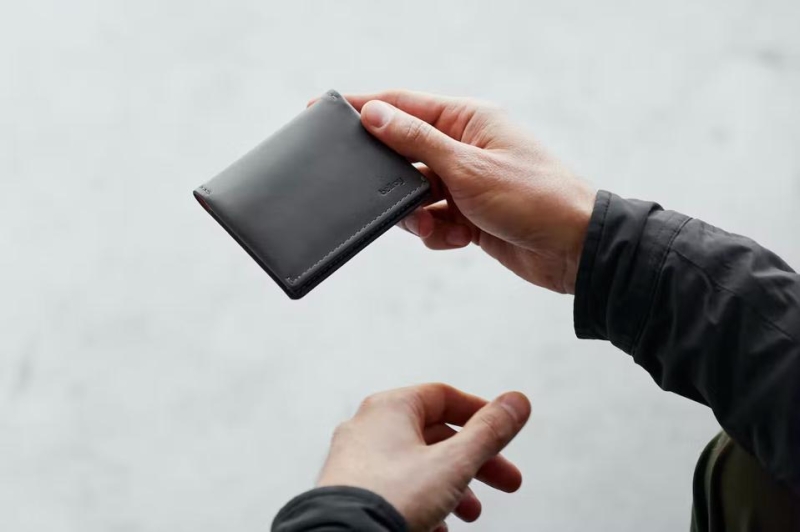
Bellroy’s wallet (shown here in Black) can easily hold five cards and some cash. And at $79, it won’t break the bank.
While I tested the wallet in the Cocoa-Java (aka brown) and enjoyed its looks, if I was buying this one for myself, I’d opt for the Terracotta—a lighter color that will get richer over time. Says Moore of the aging process: “The oils from your skin will start breaking down the leather, taking on a darker look. And that’s a conversation point in and of itself. Was that passed down from your dad? That’s a little bit of a bonus as well as a talking point.”
Speaking of talking points: In assembling a list of wallets to test, I didn’t consider the environmental impact. (Leather is a byproduct of eating meat, as a top fashion CEO once told me, and unless people stop eating meat, there will always be leather. Or as Horween says: “Anywhere with a lot of people eating beef, there will be hides.”) But I certainly appreciate that Bellroy is a certified B Corp that sources its leather from tanneries endorsed by the Leather Working Group, a nonprofit organization advocating for transparency in the supply chain. (Notably, Smythson only works with tanneries certified by the Leather Working Group). Bellroy’s Slim Sleeve also comes in a leather-free option for $99.
But again: I can’t say enough about this wallet’s size. I’ve already got an iPhone in one pocket. I don’t need to double-fist bricks, ya know? If there’s a downside to using such a minimalist wallet, it’s that you might accidentally run it through the laundry. (While the Smythson has a jagged edge that announces itself, the Bellroy—with its rounded edges—was softer, and I sometimes slid off my jeans and threw the wallet in the hamper without realizing it.)
If that should happen to you, don’t freak out. I intentionally put all of these wallets in the wash, and the Bellroy emerged fine, if a little stiff (and comparable to the other wallets I tested). Just don’t toss any leather wallet in the dryer. “Let it air-dry,” Horween says. “If it’s good-quality leather—or reasonable quality—then it was wet and dried at least a few times through the processing. The leather can take it.” But sometimes the high heat and the tumbling—that more violent action—will do more damage than letting it air-dry. You’ve been warned.
Best Slim Travel Wallet
The Indestructible Pick
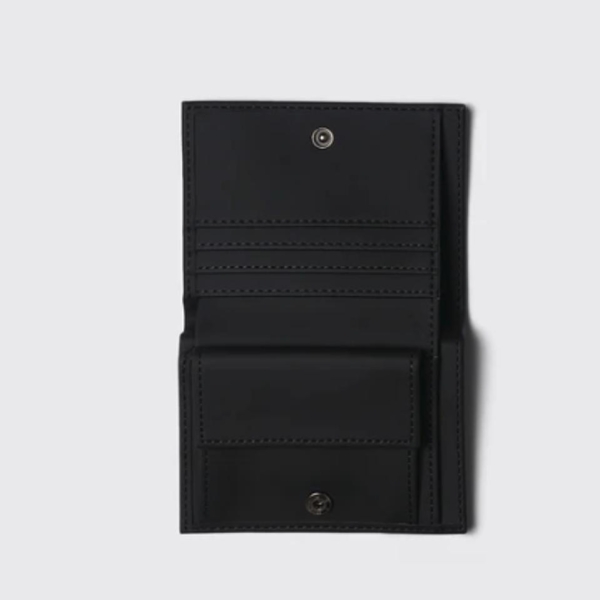
Rains Folded Wallet
Type: Bifold | Material: Polyester with polyurethane coating | Holds: 5 cards plus a coin purse | Dimensions: 4.3” x 3.5” | Thickness (empty): 1” | Thickness (full): 1.4” | Warranty: 2 years
Best for
- The adrenaline junkie who isn’t afraid to get dirty
- The man who frequently loses his wallet
- Those who prefer a leather alternative
Skip if
- You’re a cubicle warrior who doesn’t travel much
- You like tight pants that won’t easily accommodate a thick wallet like this one
First, I must admit: The Rains Folded Wallet wouldn’t be my daily carry; at 1.38″ when full, with five card slots and a snap-fastened coin pocket, it’s too thick for that. It’s also made from a stiff polyester that has a polyurethane coating and offers almost no give-and-take. But if I was on the road and needed to carry a lot of cash and cards—while keeping it all safe and dry—I’d reach for this trusty pick every time. The Rains wallet has clean lines in a waterproof material, making it perfect for throwing in your backpack, traveling on the go and living an adventure-filled life. At $50, it’s definitely a lot of fun.
Rains was founded in 2012 by two Danish design students, Daniel Brix Hesselager and Philip Lotko, and they take waterproofing seriously. They grew up in a country that averages 170 days of rain annually. I went extra hard on this wallet, running it through the laundry twice. No surprise, it fared the best of the wallets I tested; there was no visible change to its blue color or structural integrity. If anything, it looked cleaner.
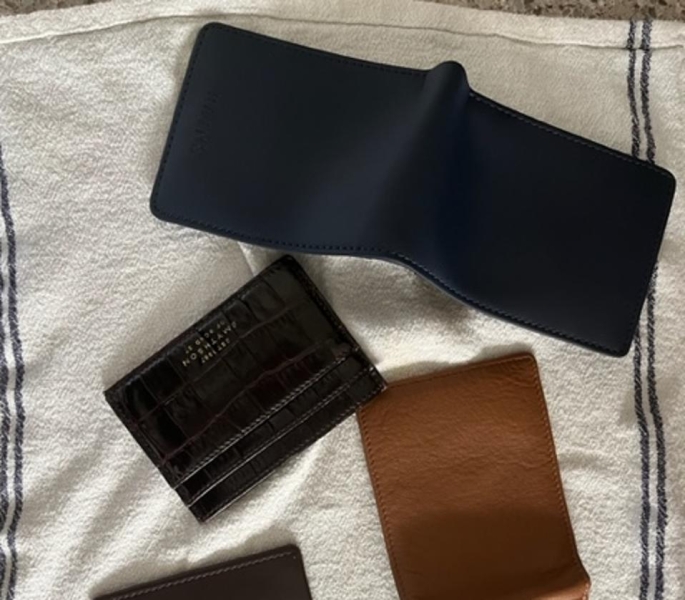
Post-washing, the Rains wallet (top) emerged good as new.
The Rains wallet comes with a 2-year warranty, but it really did appear to be indestructible. I poured hot coffee on it (no change) and tossed it in a puddle at the dog park (gross but also no change). I also ran the wallet over with my car 12 times—to mimic wear and tear but also to try to flatten it. Part of this wallet’s heft is due to an interior coin pocket, which makes more sense abroad, where coins are still a thing. But stateside it has an unintended (but awesome) use, doubling as the perfect place to stash an Apple AirTag or a Tile—a bonus if you’re someone who loses things. As Williams points out, “If a wallet can hold an AirTag, that’s a huge plus.”
Again, I can’t endorse this as a daily carry. But if you’re stashing this thing in a backpack on a hike, the size is a feature, not a bug. The Rains also has plenty of room for cash, which comes in handy when traveling, says Williams, who likes to keep a few crisp bills at the ready. (“Every time I go to a hotel, I try to bribe them for a better room,” he reveals. “You gotta know how to live.”) In the end, that’s what this wallet is about: getting out on the road and living large.
Best Slim Bifold Wallet
The Full-Size Standout
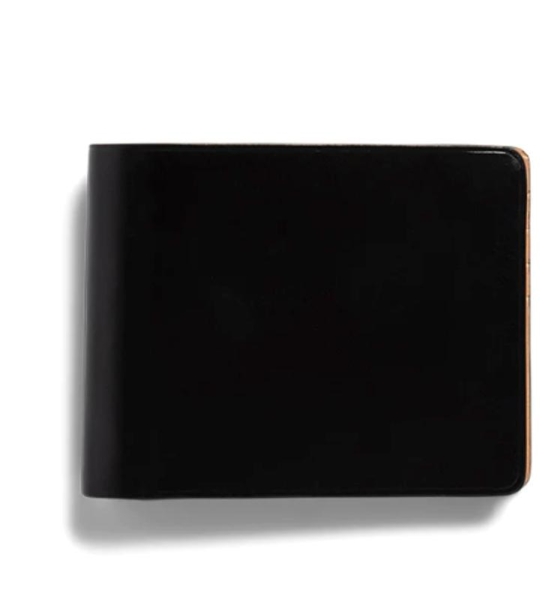
Il Bussetto Leather Wallet
Type: Bifold | Material: Leather | Holds: 8 cards | Dimensions: 4.5” x 3.5” | Thickness (empty): 0.8” | Thickness (full): 1.2” | Warranty: None
Best for
- Someone who appreciates good design from a small-batch producer
- The expense-account warrior who wants to look good (and needs room for receipts)
- The man who appreciates a wallet that might outlive him
Skip if
- You want to avoid VWL (or Visible Wallet Line)
About 5 years ago, my husband gave me an Il Bussetto wallet for the holidays. Truth be told: I had picked it out myself after eyeing it for months at a local, heavily curated boutique that doubles as a coffee shop. The wallet was royal blue, hand-painted and—I later found out—produced by a small-batch artisan out of Milan called Il Bussetto, which was founded in 2004 by a veteran of the leather trade.
When I pitched this wallet to my editor at Forbes, I felt a bit like a Little League coach hoping to install his own son on the pitcher’s mound. Or Dick Cheney chairing the vice presidential search committee only to recommend himself for the job. I already loved this wallet. J.Crew once carried the Il Bussetto as part of its “Brands We Love,” too. I was happy to rigorously test my own assumptions and—I’m even happier to report—I would buy this wallet all over again. Or, in this case, have my husband buy it again.
The Il Bussetto is beautiful and masculine, and when I’m looking to feel a bit of both, I reach for this wallet—which is just a well-constructed accessory for when you’re craving something roomy but don’t want to sacrifice style.
Let’s get the ease-of-use question out of the way. I grabbed my credit card in 2.3 seconds, but why the rush? I want to admire this wallet. And it’s worth admiring on many levels—including the construction. Il Bussetto was founded by Mauro Gobbi, an Italian leather maker who employs a unique Tuscan technique, whereby the leather goods are shaped on wooden molds; because of this, there are no seams on the outside of the wallet, only the inside, which is a compelling pitch. Stitching is usually the first failure point on a wallet, as Horween explains.
“If you use a wallet long enough, you can wear away the exterior stitching,” he says. “But if the stitching is inside the wallet, the chances of the wallet failing”—engineering speak for falling apart—“are so low.”

The stitching only appears on the inside of the Il Bussetto, where it’s protected from wear and tear.
I appreciate the care that went into this wallet’s design, but it’s also just beautiful to look at, and the color deepens over the years—in part because this is vegetable-tanned leather. A quick tutorial: Most leather is either chrome tanned (faster, with chemicals) or vegetable tanned, meaning the hide was tanned for several weeks using compounds like tree-bark extracts. Without getting too technical here, Horween explains, “Tannins are used to draw out perishable fats and oils from the leather. Those tree-bark extracts penetrate into the leather and link the fibers together and fill the empty spaces. That’s what gives leather a dense feeling.”
This isn’t a question of quality; chrome-tanned leather can be quite resilient because of the chemicals. But when it comes to color and wear, Williams likens veg-tanned leather to “raw denim,” saying: “When you wear it and use it, it gains that patina.” That’s certainly the case with my Il Bussetto, which has softened like an old briefcase inherited from Grandpa but hasn’t lost any of its structure. I drove over the thing with my car (no change) and ran it through the wash—painful, I admit, but thankfully the color remained.
Other Wallets I Tested
I ultimately decided not to test luxury goods like the classic Louis Vuitton wallet or a Goyard card case. In the end, I felt that luxury wallets produced by venerable fashion houses were presumably well made. Also: I couldn’t stomach sending a Goyard card case through the wash.
I briefly discussed testing a vegan option with my editor, though it didn’t seem like a motivating factor when selecting a wallet; also, the Bellroy is available in a plant-leather option (for a small surcharge). And Rains, which doesn’t use leather, is heavily committed as a company to reducing its carbon footprint.
I did, however, test a few products I liked for various reasons but that didn’t ultimately make the cut.
Ridge Forged Ember: This wallet was good fun—like a magic wallet for adults. Picture two carbon-fiber end pieces held together by a strap. But the novelty wore off for me after a few days. And the add-on money clip, while useful in theory, ruined the wallet’s clean lines, so I’d opt for a separate money clip instead. Again: The Ridge was lots of fun. I sometimes felt like a dad on a camping trip. Ultimately it was more like a gadget than a wallet, but that might be nice for the gearhead in your life.
The Herschel Hank Wallet: This is the kind of wallet you’d give a high schooler for graduation, which isn’t a knock. It’s got heft (especially for a $65 price point). But the see-through window for an ID card felt Spicoli-ish. And the metal logo glued to the front of the wallet didn’t help matters. (Maybe they agree. The current version has the logo debossed.)
Leatherology Thin Bifold Wallet: This was surprisingly slim for a full-size wallet. I enjoyed using this one more than I expected. But the leather on the $70 entry-level model didn’t pass muster; I might have felt differently if I’d upgraded to the premium leather ($100). But for that price, I’d recommend the Il Bussetto wallet, which is a steal right now thanks to how strong the dollar is against the euro, plus it has fewer failure points thanks to its unique construction.
How I Tested The Best Slim Wallets
I evaluated the wallets on two main criteria: construction and looks. How well did the wallet stand up to repeated use? Did the stitching come apart? What might happen if I ran it through the laundry (as people are known to do accidentally)? I also took a look at how each wallet made me feel: Did it make my heart race? Might it make the person next to me envious?
To gauge durability, frankly, I abused the wallets. I repeatedly ran each one over with my car (imitating wear and tear). If you’d driven past my house in Los Angeles, you would have seen a strange man (me) driving an Audi A4 back and forth over each wallet—12 times—in his driveway. I’m also an avid runner and was curious to see how each wallet would react to sweat. (I’m not changing out my wallet for a workout.) Would the sweat leave a hard-to-remove stain? I did a 5-mile run with the wallets tucked into my waistband to check for the dreaded chalky-white sweat marks. I counted the stitches per inch, a standard industry measure of quality, and I threw each wallet in my Frigidaire washing machine on the quick cycle with a half cap of detergent for 33 minutes, to see how it fared when washed.
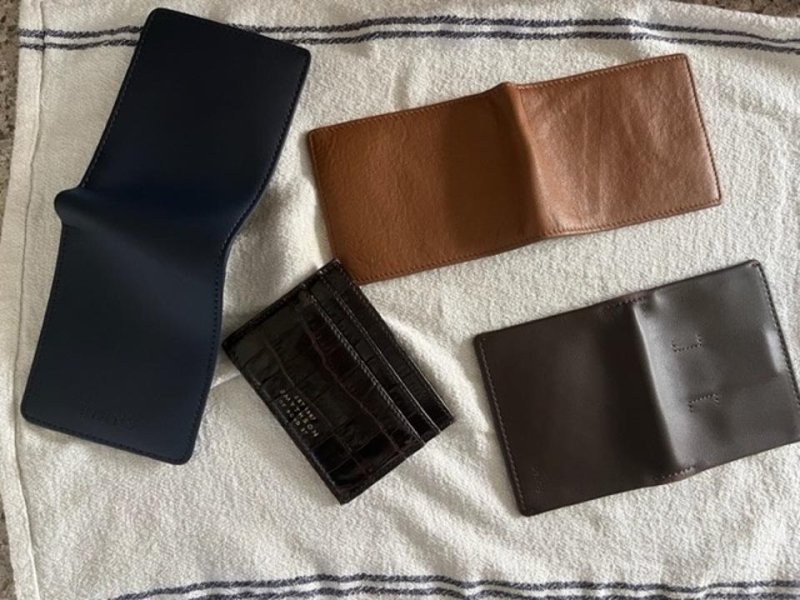
I put the wallets I tested through the washing machine to see how the materials held up to the abuse.
Was this silly? Was it overkill? Moore didn’t think so, letting me in on an industry secret: “If we were working late at night and needed the accessories to look beat up [for a photo shoot], we’d go downstairs and have a [town car] run them over—back and forth.” While he was doing this for aesthetics, that same gambit let me test for the rigors of daily use, ensuring readers would find a wallet that’s durable and will last a lifetime, or at least until you decide you want to mix things up.
I also measured each wallet’s thickness, hyper aware of the “George Costanza problem”—a reference to the Seinfeld character’s notoriously overstuffed wallet. I dutifully measured each wallet for thickness—empty at first, and then again with four credit cards and five $20 bills stashed inside. I was also mindful of another common problem: fumbling for a card at a coffee shop while 30 people in line are staring at your back. And so I mimicked the checkout experience at home, using a stopwatch to time myself reaching for the wallet and removing my American Express card.
Maybe just as importantly, I left the wallets out where people could see them—on a desk at a shared office space, on the counter at a local bookstore and at a hot new restaurant in L.A., where I ran into a very famous movie star (more on that below). Which wallets drew compliments? Which were ignored entirely? And, on the most basic level, which ones did I reach for again and again, and which languished on the nightstand?
How To Pick A Wallet
Shopping for a wallet should be fun. “Consumerism is back,” says Moore, who encourages you to take your time and enjoy the process. “It’s an extension of your personal style. If you need another pair of gym shorts or a five-pack of T-shirts, Amazon yourself crazy. But if you want a wallet or a card case, go shopping.” Moore wants you to hold a potential wallet in your hand and see how it makes you feel. And I get it.
Here are a few questions to consider when you’re shopping for a wallet: How much cash do you regularly carry? Do you travel abroad frequently and could thus use a coin purse? Are you someone who regularly misplaces their wallet and might benefit from a designated spot to hide an AirTag? How much are you comfortable spending? What is your taste level? Are you out to impress friends? Or is this purchase more about function over formality?
What to spend on a wallet is a personal decision. A Goyard card case (made by the venerable French fashion house) could run you $500. Bottega Veneta sells one in its classic woven style for $350. You can also get a workable leather card case from Target for $15. Wallets come in a similar range of prices. What are you comfortable spending? Again, that’s personal. Though maybe think about it this way: How long do you want to hold on to this wallet?
Says Moore: “If you buy a wallet at Louis Vuitton or Hermès, it’s maybe $750. It’s super beautiful leather, it has a cachet. But it’s also something that can be repaired. You’ve got value there.” Williams echoes the point: “I’d rather spend the money upfront than buy one every year.”
As for ease of use, all of the wallets I tested performed as directed. In many instances, the final choice comes down to aesthetics, especially if you’re looking for a card case, which Moore considers “fashion—it’s an extension of your personal style.” No matter the price, have fun with it.
I could talk about leather quality all day. And it’s important to start with a good base, says Horween. “In any tanning process, the most important input is the hide itself. If you don’t have a good foundation, it doesn’t matter what you do.” Cheap leather is often just a veneer: a thin piece of leather backed by nylon (for strength), held together by glue. This is rarely a good idea. “Any time there is glue,” Horween says, “especially in an item you’re using a lot—and one that’s subject to heat and humidity from your body—there’s a chance that glue is a failure point.”
But he also points out that when it comes to a wallet falling apart, “A lot of time it’s not the leather, it’s the construction.” Even in a more expensive wallet, stitching is often the first failure point. There is an industry standard measurement—stitches per inch—that denotes quality. The wallets I tested were all around the same—between eight and 10 stitches per inch—and of good quality. But if you’re rough with your wallet, you might want to consider the Il Bussetto, which has stitches only on the inside and is basically protected from the beating of daily repeated use.
If you’re looking for leather that will soften with time—like a good leather duffel bag—look for vegetable-tanned leather (explained above). Williams likens this to raw denim, and he’s right: It breaks in beautifully. By contrast, the Rains wallet—made from polyurethane—shouldn’t show its age at all. It’s a synthetic material that’s unaffected by the oil on your hands. Thanks to its nonabsorbent composition, there’s nowhere for the oil to seep into.
While we’re on the topic, Horween is frequently asked about wallet maintenance and how often you should oil you wallet, to which he replies: never. You don’t need to condition or shine your new leather wallet, he explains, saying: “The oils from your hands should be enough to keep your wallet smooth and shiny. The answer is to use it.”
My Expertise
As for my own bona fides, I’m a wallet completist. (Don’t say hoarder!) My daily carry is a caramel bifold I bought 10 years ago from a small-batch purveyor in Brooklyn called M&U Co., which has worn in beautifully, like an old baseball mitt. (Sadly, M&U Co. no longer appears to make this wallet). I also have a black Prada card case for formal occasions. For some reason, I also own a fake Louis Vuitton x Supreme wallet that I bought late one night from a Manhattan street vendor after drinking three martinis.
I’m not just a collector. I have a deep appreciation for craftsmanship, honed over years of being an obsessive consumer, former editor at GQ and occasional style writer for publications like Esquire and Men’s Journal. I’ve toured the heritage brand Filson’s factory in Seattle and talked leather with a cobbler at the French sneaker company Veja’s warehouse outside Paris. I’m also not afraid to ask a total stranger for their sartorial opinion, which is maybe embarrassing for me. But my loss is your gain.
To determine the best men’s wallets, I first interviewed a panel of experts, including Jim Moore from GQ. I also interviewed Michael Williams, who writes the influential men’s fashion newsletter A Continuous Lean; his motto is “buy less, buy better,” which will serve men well as they (potentially) splurge on a wallet. Finally, I spoke with Nick Horween, director and quality manager at Horween Leather Company, a fifth-generation family business out of Chicago. He is an expert on tanning and production, and (as his title confirms) he’s an excellent judge of a wallet’s quality.
After speaking with these experts, I took a deep dive into the market to find the best men’s wallets to test. I considered more than 25 options before narrowing the list to seven. I chose a mix of full-size bifold wallets, slim card cases and a few technical, out-of-the-box choices (including one made of carbon fiber). I also looked at various price points but ultimately avoided the highest-end luxury models (see below) and capped things at a reasonable-ish $250.


